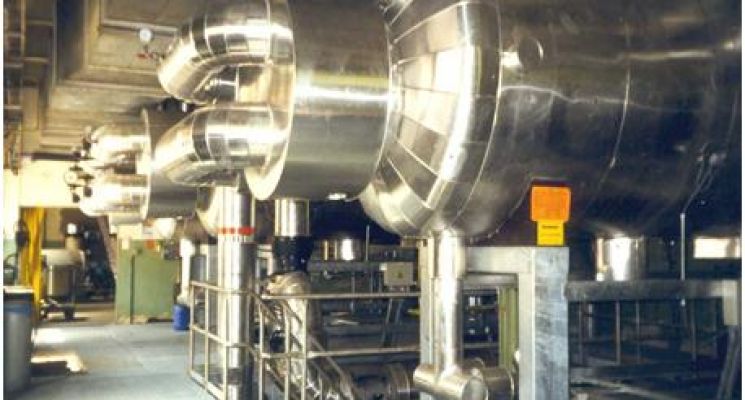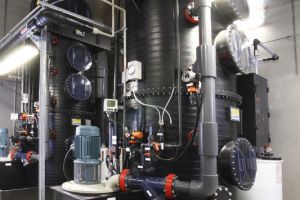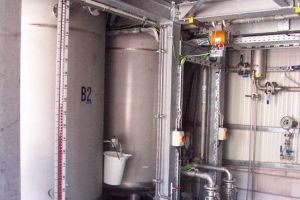ANCILLARY SYSTEMS FOR YOUR SPINNING PROCESS
A number of ancillary systems are necessary for the operation of spinning plants. These systems must be meticulously adjusted to the requirements of the primary spinning system. If the plant is not part of an industrial park, these ancillary systems are frequently missing and must be created onsite. For example, these systems include: various supplies of cooling water, hot water, thermal oil, conditioned air, compressed air, softened and desalinated water, a waste water system, an exhaust air system and other ancillary services. The layout and arrangement of these systems in the spinning plant should follow specific procedures that have been tested multiple times and have been adapted to the spinning system. The use of chemicals makes storage in tank facilities or silos mandatory.
Wet spinning processes in particular use chemical solvents like DMF, DMAC, DMSO, NMP and others. Often these solvents are mixed with water during the procedure. When there is evidence of feasibility, these solvents can be recovered & recycled. Storage containers must be provided for the storage of recovered solvents and for mixtures of solvents and water. These containers must be connected to piping systems that connect to the production systems as well as with the recovery units. Our company will design a storage tank system (including balancing systems, pipelines, pumps, heat exchangers and other structural attributes) ror the layout of the tank facility, which will takebuffering in case of malfunctions as well filling using tank trucks into consideration, as part of the framework conditions for your spinning process. If the liquid materials handled in a system are particularly hot, they will be evaluated for the feasibility of recycling the heat.
Polymer-solvent mixtures are used as spinning solution during many spinning processes in order to generate specific properties in the fibres, sheets or films produced. The correct proportion and an efficient mixing system must be chosen in order to dissolve the polymer in the solvent in the correct ratio. The formula can be adjusted using a weighing system or quantitative individual systems for determination proportions. Frequently, these mixtures are dissolved uniformly in mixing tanks or intensive mixers with the additional effects of temperatures. The best possible uniformity in the mixing system is ensured by our many years of experience in project management and in the construction and operation of preparation units. The components will be combined, degassed and filtered directly from the tank storage system or silo at the lowest tolerances for the composition.
Melt spinning polymers are melted in the extruder and transferred to a fluid melt. Corresponding polymer proportions are needed as well. Normally these are handled with gravimetric methods meeting the respective dosing accuracy.
The steps of the degassing and filtration processes are basic prerequisites for the successful production of fibres.
The spinning solution must be degassed in most fibre production systems, in order to remove small gas bubbles or air-inclusions introduced during mixing as part of batch production and are nearly invisible. There are a number of different removal processes.
- Batch degassing
- Degassing with thin-film evaporator
- Degassing in the extruder
- Degassing at boiling point
- Membrane contactor
We can offer practical experience with the procedures indicated above. The various batches will be examined with regard to their applications. Using technical and economical comparison, we will determine the ideal procedure for you.
Stable fibres cannot be produced without a first-class filtration system for the solution. Therefore, the spinning solution and melt filters have to be designed and manufactured according to your system’s requirements –based on the respective pressure, temperature and viscosity as individual properties.
The quality of filtration extends to a cut-off value of an absolute 3 micrometres. Options that can be used include:
- individually standing, heated housings that receive multiple filter cartridges
- double arrangement of the filter housings as replaceable filter cartridges
- quick change-over filter housing with a filter cartridge in multiple arrangements with an option for heating
- cartridge filters integrated in nozzle housings, which are widely used in hollow fibre nozzles

Storage tank systems

Mixing stations for various applications

TiO2 proportioning station
